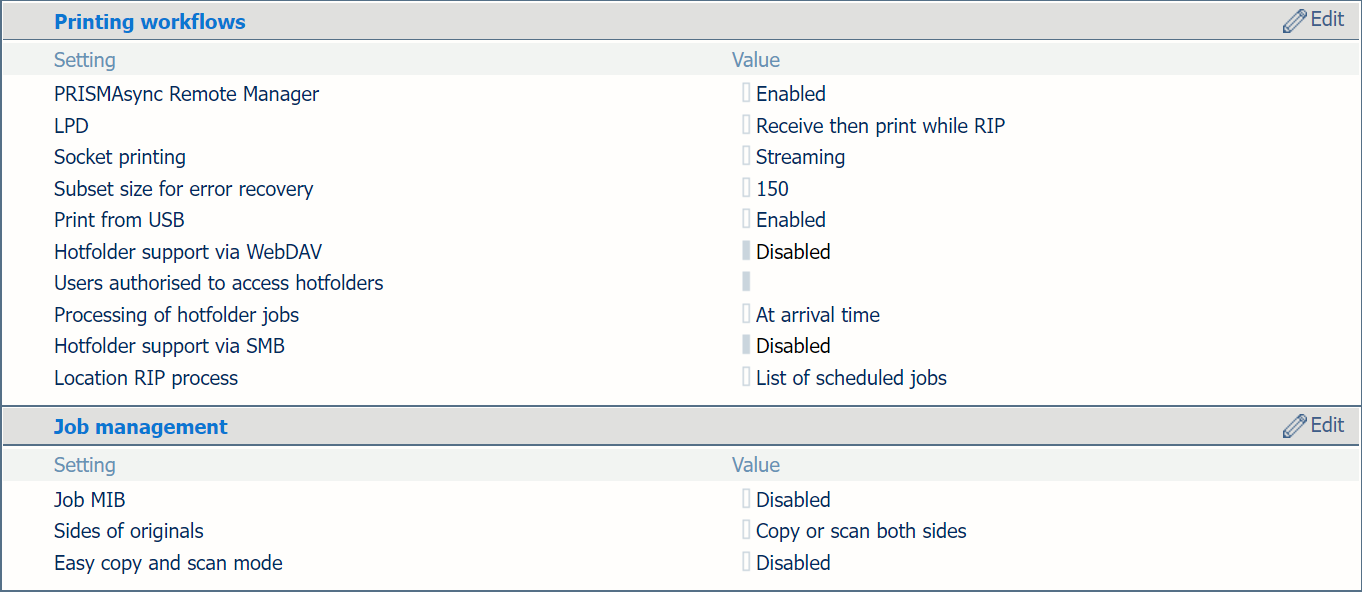

You can define how jobs are processed by default.
Open the Settings Editor and go to: .
 [Definições de sistema] tab
[Definições de sistema] tabGo to the [Fluxos de impressão] and [Gestão de trabalhos] sections.
 [Fluxos de impressão] and [Gestão de trabalhos] sections
[Fluxos de impressão] and [Gestão de trabalhos] sectionsThe printer protocol LPD can be enabled by the system administrator. The print protocol LPR must be installed on the workstation that submits the jobs.
Use the [LPD] setting to indicate when the RIP starts to process LPR jobs.
[Transmissão em sequência] is applicable to large jobs. The job is processed by the RIP and printing can start at the same time.
[Receber e imprimir durante RIP] is the default value and is applicable to smaller jobs that have multiple sets. The RIP starts to process the jobs after they arrive in the print queue and before the whole job has been received.
 [LPD] setting
[LPD] settingSocket printing can be enabled and configured by the system administrator.
Use the [Impressão via socket] setting to indicate when the RIP starts to process jobs that use the socket printing port.
[Transmissão em sequência]: is default value and applicable to large jobs. The job is processed by the RIP and printing can start at the same time.
[Receber e imprimir durante RIP]: is applicable to for smaller jobs that have multiple sets. The RIP starts to process the jobs after they arrive in the print queue and before the whole job has been received.
 [Impressão via socket] setting
[Impressão via socket] settingUse the [Tamanho de subconjunto para recuperação de erros] setting to define the number of pages that will be printed again after the error is solved.
 [Tamanho de subconjunto para recuperação de erros] setting
[Tamanho de subconjunto para recuperação de erros] settingThe system administrator can change the processing order of hotfolder jobs.
Use the [Processamento de trabalhos de hotfolder] setting to indicate how jobs are processed in the hotfolder.
[No momento de chegada]: job processing takes place when the job arrives in the hotfolder.
[Ordem baseada no nome dos trabalhos]: job processing takes place according to the alphabetical order of the job names.
 [Processamento de trabalhos de hotfolder] setting
[Processamento de trabalhos de hotfolder] settingUse the [Imprimir a partir de USB] setting to indicate whether printing from a USB drive is allowed.
 [Imprimir a partir de USB] setting
[Imprimir a partir de USB] settingUse the [Processo de localização RIP] setting to indicate where the RIP processes jobs when they arrive in the print queue.
[Todas as localizações]: the RIP can process jobs in all job destinations.
[Lista de trabalhos agendados]: the RIP can only process jobs when they are in the list of scheduled jobs.
 [Processo de localização RIP] setting
[Processo de localização RIP] settingUse the [Trabalho MIB] setting to indicate if remote monitoring of jobs via SNMP is allowed.
 [Trabalho MIB] setting
[Trabalho MIB] settingUse the [Lados dos originais] setting to indicate if originals have information on one or both sides.
 [Lados dos originais] setting
[Lados dos originais] settingUse the [Modo de cópia e leitura fácil] setting to indicate that you want to enable the easy copy and scan mode.
[Activado]: the last used job template will be re-opened when the operator starts a new copy or scan job.
[Desactivado]: the last used job template will close when the operator starts a new copy or scan job.
 [Modo de cópia e leitura fácil] setting
[Modo de cópia e leitura fácil] setting